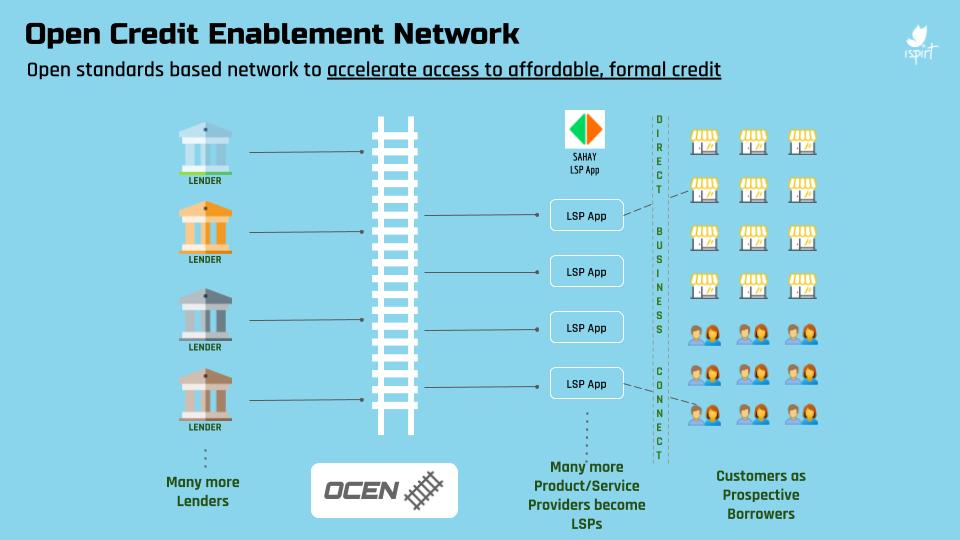ONDC Financial Services or OCEN protocol & Account Aggregators will change digital lending in India
On 22nd July at the Global Fintech Festival 2020, Nandan Nilekani announced the launch of the Open Credit Enablement Network (OCEN) (ONDC Financial Services or OCEN protocol), which would mark the beginning of a new age for financial inclusion in India. Working in tandem with the Account Aggregator framework, this extension of our public digital infrastructure will help to democratise credit for a significantly credit-starved population.
The Problem
India has a credit gap of over $330 bn due to the failure of traditional lenders to guide credit into the hands of the people and businesses that need it most. The unit economics of our current lending set-up makes it difficult for banks and NBFCs to provide loans to borrowers in a timely manner, at the right cost of capital, and tailored to their individual requirements. Innovation in lending has been restricted by the time and costs involved in discovering and servicing new customers, gathering documents and collecting payments.
Banks that have the lowest cost of capital (from deposits) typically lend to larger enterprises who have a higher ticket size requirement. Smaller MSMEs (that make up a vast portion of our GDP, employment and exports) often cannot provide the necessary data or collateral to avail of bank loans even though they have the most urgent requirement for working capital. They have to rely on NBFCs who charge a higher rate of interest to account for both a higher cost of capital and a relatively riskier customer base.
The last decade has seen the emergence of marketplaces, platforms and aggregators in our tech ecosystem that represent new digital touchpoints for both consumers and businesses. In theory these should be empowered to play a role at different levels in the credit value chain. However the process of integrating with lending partners is cumbersome, complicated and non-standardised.
India needs to re-architect its current credit rails at both the product and process level so that we can achieve our full economic potential.
The Solution
ONDC Financial Services or OCEN protocol is a new paradigm for credit that seeks to ‘provide a common language for lenders and marketplaces to build innovative, financial credit products at scale’.
The ONDC Financial Services or OCEN protocol provides a standardized set of APIs so that applications that already interface with individuals and MSMEs can effectively ‘plug-in’ lending capabilities into their current product and service offerings.
These ONDC Financial Services or OCEN protocol-enabled marketplaces are called Loan Service Providers (LSPs) and play a novel role as borrower-facing agents or intermediaries in this reimagined digital lending flow.

By activating these service providers to be a source of customer discovery and credit delivery, ONDC Financial Services or OCEN protocol will allow for the creation of several new types of loan offerings. These new financial products can be designed around the unique requirements of borrowers. This also enables customers to leverage the data that is already being captured by these Buyer applications or LSPs so that lending can become a cash-flow based operation instead of the current balance sheet focus.
For Buyer Applications or LSPs, this provides a seamless way to cater to the demands of their customers and more holistically expand their offerings. At the same time, this allows borrowers to obtain credit within the course of their daily business activities and leverage new data flows to be eligible for loans. And finally, ONDC Financial Services or OCEN protocol gives lenders the ability to widen their market and provide innovative credit products while reducing the cost of acquiring customers.
The same ease that UPI unlocked for payments, ONDC Financial Services or OCEN protocol will unlock for credit.
The Role of Account Aggregator in ONDC Financial Services or OCEN protocol
Account Aggregators function as enablers in this ONDC Financial Services or OCEN protocol-powered credit landscape. Buyer Applications or LSPs must embed AA API’s into their flow so lenders can digitally and securely request for borrower data.
Using their AA handles, borrowers can consent to share officially verified data with lenders that will be incorporated in the onboarding, underwriting, and monitoring process.
The data received from a borrower’s Financial Information Provider (GST, Bank accounts etc) will be in a machine-readable format (XML, JSON) that can be easily digested by the lender’s underwriting model.
Without implementing AA’s FIP and FIU modules, the lenders will not be able to participate in this new lending marketplace.
Account Aggregators are a vital piece of this reimagined credit puzzle and will be an important cog in the success of any ONDC Financial Services or OCEN protocol and Buyer Application or LSP-enabled lending value chain.